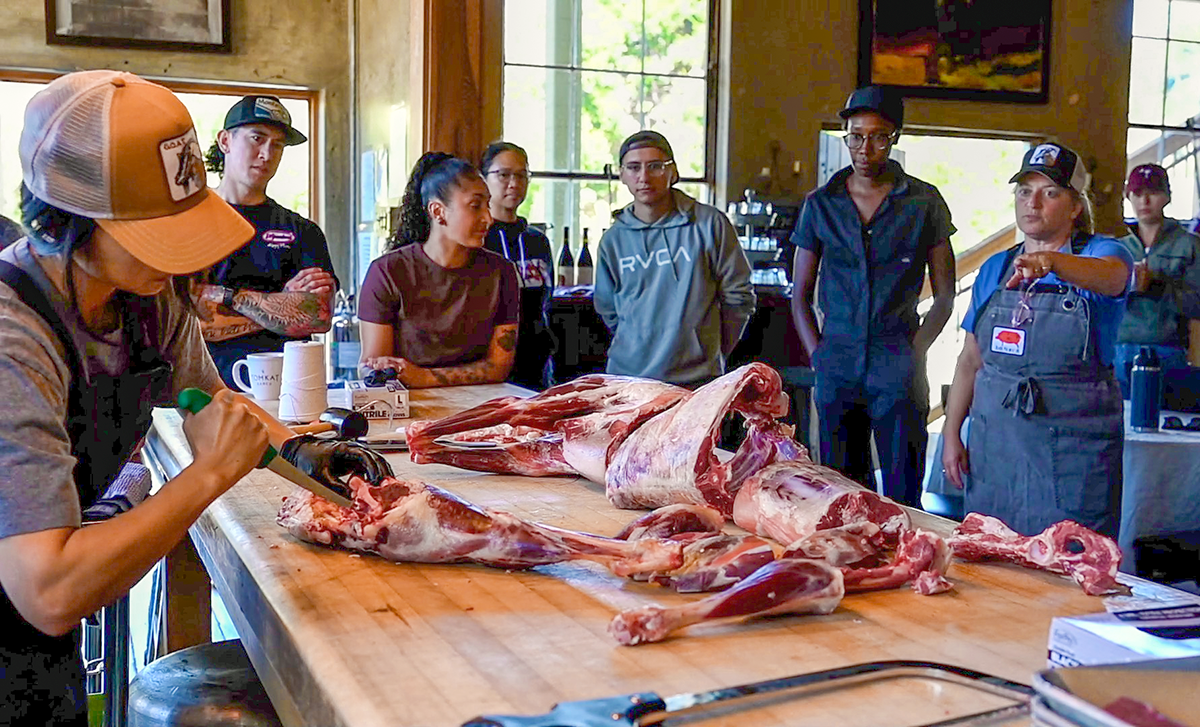Two million meat goats are being raised in the US, and at least 90,000 (as of 2019) of them come from California.
Ode to Goat Meat

10/23/2024
By: Jack Towers
Two million meat goats are being raised in the US, and at least 90,000 (as of 2019) of them come from California. These numbers are part of a larger trend of increased demand for goat meat by consumers from cultures where goat meat is common, and by the supply side as a way to turn an additional penny as goats get older and lose value for small producers with tight margins. For regenerative ranchers, goat meat is an emerging product in the sustainable food market. Following conversations with the Small Ruminant and Fork to Farm Teams at TomKat Ranch, I wanted to share some of the opportunities and benefits of expanding goat meat production. This article also follows a recent Fork to Farm goat butchery workshop (pictured) that was part of TKREF’s Gathering for Action initiative. Read about our goat butchery workshop here.
For the past decade, multiple drivers have been identified in increased demand for goat meat production. For one, as the US continues to be a hub for diverse cultures, immigrants and existing communities with Hispanic, Middle Eastern, Southeast Asian, and Caribbean backgrounds seek out goat meat as an established cultural item. Simultaneously, health-conscious consumers with an interest in low-fat sources of protein are drawn to goat meat for its leanness:
| Type of Meat | Fat Content (in 3 oz) (g) |
| Goat | 2.6 |
| Beef | 7.9 |
| Chicken | 6.3 |
Others are interested in goat meat from a culinary perspective, exploring a new, more niche protein with a distinct flavor profile. For ranchers, especially regenerative ranchers already employing multiple species to graze their lands to confer benefits (greater utilization of forage, improved soil health, and increased biodiversity among others), goat meat production could represent a logical next step. In conversation with folks at TomKat Ranch, this idea holds promise but requires extending capacities to our existing LeftCoast GrassFed beef sales to enter this potentially profitable niche market.
To further understand how expanded goat meat production can fit into sustainable ranching practices, it’s worth stepping back and thinking about the benefits of small ruminants in general for regenerative agriculture. Small ruminants (primarily sheep and goats), due to their size, behavior, and diets, confer different benefits compared to cattle. Goats, specifically as browsers, are useful for managing encroaching brush and keeping land clear for other grazers. They also put less pressure on the soil and can navigate spaces too small or steep for cattle and larger animals. This enables them to manage undesirable species that may otherwise proliferate.
For ranchers interested in, or already using goats to support the management of land, (especially woody brush encroachment) use of goats can also provide additional revenue and protein from their practices. Combined with cattle grazing and controlled burning, goats can generate higher net present value. They can also inhibit the presence of woody plants which can block access to forage and exhaust the water supplies needed for more beneficial crops. According to Langston University Goat Extension Leader Dr. Terry Gipson, the return on investment can sometimes exceed that of cattle; “I am not saying that you make more money on goats than you do cattle, but for the investment that you put into it, you get a greater return on that investment.”
Goats are not a universal solution; the context of each operation will determine whether they are the right choice for the land. However, should they be deemed beneficial, they can offer a unique and growing source of revenue, and cater to the needs of consumers not entirely captured by beef and other animal products. Furthermore, they are strongly aligned with sustainable and regenerative agricultural practices because of their distinct impact and unique ecosystem services.
Jack Towers studies Environmental Science and Public Policy, and Integrative Biology at Harvard, and was a summer intern at TomKat Ranch.